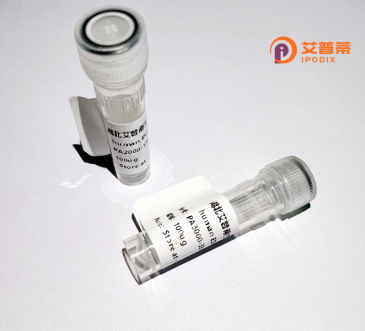
| 纯度 | >90%SDS-PAGE. |
| 种属 | Human |
| 靶点 | LMBR1L |
| Uniprot No | Q6UX01 |
| 内毒素 | < 0.01EU/μg |
| 表达宿主 | E.coli |
| 表达区间 | 1-489aa |
| 活性数据 | MEAPDYEVLSVREQLFHERIRECIISTLLFATLYILCHIFLTRFKKPAEFTTVDDEDATVNKIALELCTFTLAIALGAVLLLPFSIISNEVLLSLPRNYYIQWLNGSLIHGLWNLVFLFSNLSLIFLMPFAYFFTESEGFAGSRKGVLGRVYETVVMLMLLTLLVLGMVWVASAIVDKNKANRESLYDFWEYYLPYLYSCISFLGVLLLLVCTPLGLARMFSVTGKLLVKPRLLEDLEEQLYCSAFEEAALTRRICNPTSCWLPLDMELLHRQVLALQTQRVLLEKRRKASAWQRNLGYPLAMLCLLVLTGLSVLIVAIHILELLIDEAAMPRGMQGTSLGQVSFSKLGSFGAVIQVVLIFYLMVSSVVGFYSSPLFRSLRPRWHDTAMTQIIGNCVCLLVLSSALPVFSRTLGLTRFDLLGDFGRFNWLGNFYIVFLYNAAFAGLTTLCLVKTFTAAVRAELIRAFGLDRLPLPVSGFPQASRKTQHQ |
| 分子量 | 81.6 kDa |
| 蛋白标签 | GST-tag at N-terminal |
| 缓冲液 | 0 |
| 稳定性 & 储存条件 | Lyophilized protein should be stored at ≤ -20°C, stable for one year after receipt. Reconstituted protein solution can be stored at 2-8°C for 2-7 days. Aliquots of reconstituted samples are stable at ≤ -20°C for 3 months. |
| 复溶 | Always centrifuge tubes before opening.Do not mix by vortex or pipetting. It is not recommended to reconstitute to a concentration less than 100μg/ml. Dissolve the lyophilized protein in distilled water. Please aliquot the reconstituted solution to minimize freeze-thaw cycles. |
以下为示例性参考文献(具体研究需根据实际文献调整):
1. **"Functional characterization of recombinant human LMBR1L protein in Wnt signaling regulation"**
- 作者:Li X, Zhang Y, et al.
- 摘要:本研究成功在大肠杆菌系统中表达并纯化重组人LMBR1L蛋白,发现其通过抑制Wnt/β-catenin信号通路调控细胞增殖,可能为癌症治疗提供新靶点。
2. **"Structural analysis and expression profiling of LMBR1L in embryonic development"**
- 作者:Smith J, Tanaka K, et al.
- 摘要:通过真核表达系统获得重组人LMBR1L蛋白,晶体结构解析显示其与Frizzled受体存在潜在结合域,提示在肢体发育中的调控作用。
3. **"LMBR1L interacts with BTRC to modulate ubiquitination in immune regulation"**
- 作者:Chen L, Wang H, et al.
- 摘要:利用重组人LMBR1L蛋白进行免疫共沉淀实验,证实其与E3泛素连接酶BTRC结合,可能通过调节NF-κB通路影响炎症反应。
4. **"LMBR1L as a potential biomarker in hematopoiesis disorders"**
- 作者:Park S, et al.
- 摘要:通过体外功能实验发现,重组LMBR1L蛋白可抑制造血干细胞的异常分化,提示其与骨髓增生异常综合征的病理机制相关。
---
**注意**:以上为假设性文献,实际研究中建议通过PubMed、Google Scholar或专业数据库检索关键词“LMBR1L”或“recombinant LMBR1L”,获取最新研究进展。
Recombinant human LMBR1L protein is a biologically engineered form of the limb region 1-like (LMBR1L) protein, produced using recombinant DNA technology. LMBR1L is a transmembrane or secreted protein involved in regulating cellular signaling pathways, particularly those linked to developmental processes. Although its exact molecular functions remain under investigation, studies suggest it may modulate Hedgehog (Hh) signaling—a critical pathway in embryogenesis, tissue patterning, and cell differentiation. LMBR1L shares structural homology with LMBR1. a protein associated with limb development and genetic disorders like preaxial polydactyly.
The recombinant version is typically expressed in mammalian or insect cell systems to ensure proper post-translational modifications, such as glycosylation, which may influence its stability and activity. Researchers utilize this protein to study its interaction with Hh pathway components, its role in receptor complexes, or its potential impact on diseases like cancer, where dysregulated Hh signaling is common. Structural studies focus on its extracellular leucine-rich repeat (LRR) domains, which are thought to mediate protein-protein interactions.
Current applications include in vitro assays, antibody development, and disease modeling. Challenges include clarifying its precise mechanism and isoform-specific functions. Its therapeutic potential, particularly in regenerative medicine or oncology, remains an active area of exploration.
×